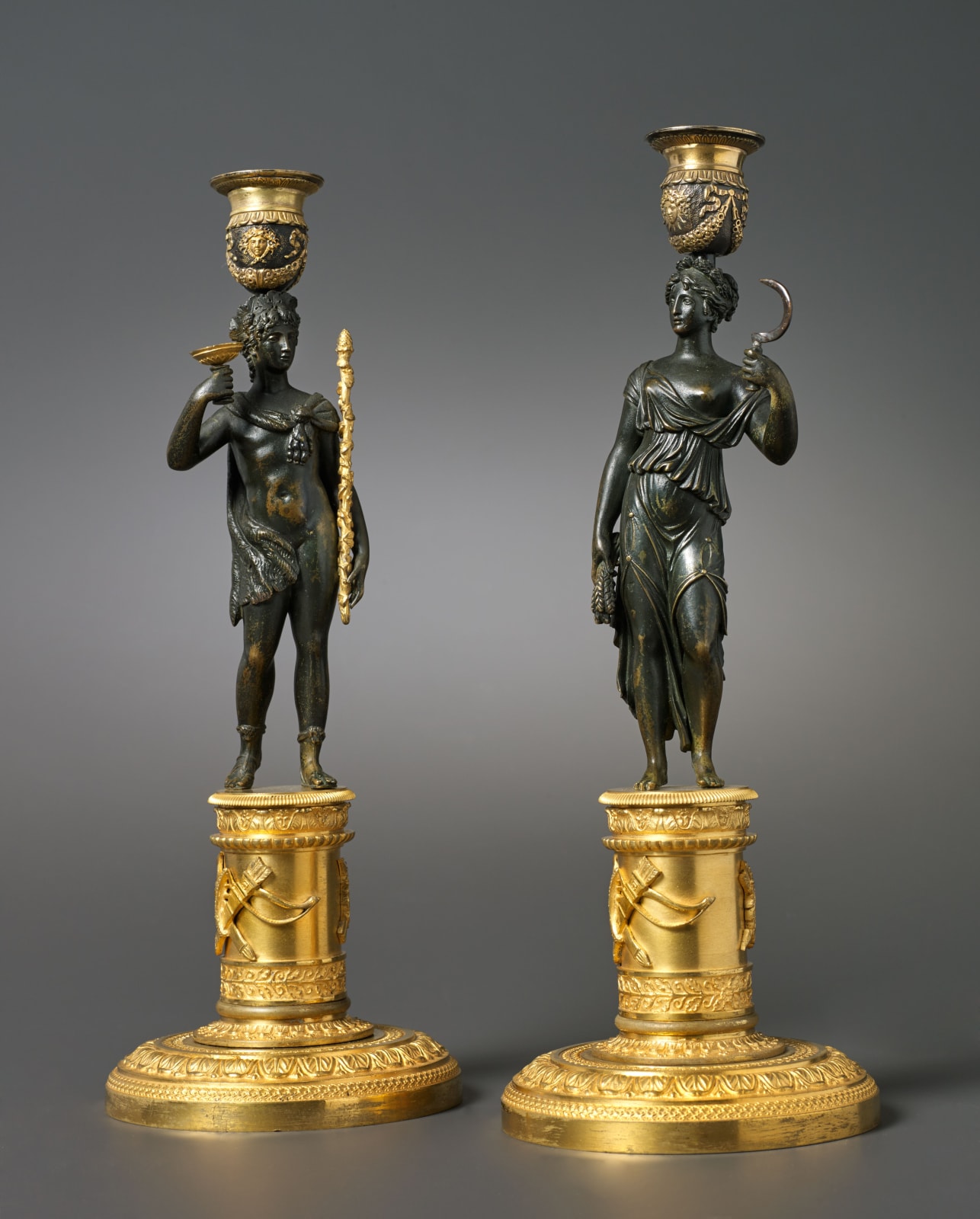Pierre-François Feuchère (attributed to)
Literature
Hans Ottomeyer and Peter Pröschel, “Vergoldete Bronzen”, 1986, p. 334, pl. 5.2.14, illustrating a candelabra of circa 1805 featuring a very similar female figure as here as well as laurel wreaths upon an angular plinth and pl. 5.2.16, illustrating another candelabra by Feuchère with a very similar female figure as here.
An extremely fine pair of Empire gilt and patinated bronze candlesticks attributed to Pierre-François Feuchère, one with its shaft representing Summer in the form of the ancient goddess Ceres as a beautiful classical semi-nude female with coiled hair, wearing a diaphanous dress, holding a sheaf of corn in her right hand and aloft in her left hand a sickle, the other candlestick with shaft representing Autumn formed as the young Bacchus wearing vine leaves in his hair, a leopard skin as a cloak and sandals on his feet, holding in his raised right hand a cup and in his left hand a thyrsus with pine-cone finial and shaft enveloped with vine leaves, both figures supporting on their heads a vase-shaped candle holder with circular splayed rim above a stiff leaf border and mounted on one side by an Apollo sunburst mask and on the other the head of Medusa with a crescent moon headdress respectively symbolising day and night, each mask head separated by a ribbon-tied foliate swag, both Summer and Autumn standing on a circular gilt bronze plinth mounted with a laurel leaf wreath enclosing a pair of crossed arrows above a spreading stepped circular foot adorned with foliate borders
Paris, date circa 1805-10
Height 31 cm. each.
These magnificent candlesticks represent Summer and Autumn, one of the Four Seasons – a subject that was traditional in Western art since the Renaissance and a much favoured allegorical theme during the eighteenth and early nineteenth centuries. No expense has been spared to include their intricate iconographic details. Hence Summer is shown semi-nude as Ceres, the mythological goddess of agriculture who holds her attributes, namely a sheaf of corn and sickle while Autumn, commonly associated with the grape harvest is symbolised by the young Bacchus.
He has vine sprays in his hair, a leopard pelt as a clock, a cup in one hand and a thyrsus wrapped around with vines in the other, all of which are attributes of the mythological god of wine. Further allusions to the changing seasons is shown on the candle holder in the guise of an Apollo sunburst representing day while night is symbolised by Medusa who wears a crescent moon, so often associated with the mythological moon goddess Luna.
Given their quality and overall style this superb pair of candlesticks can be attributed to the Parisian bronzier Pierre-François Feuchère (1737-1823) who produced a number of figural candelabra of similar form. As the head of the one of the largest firms of Parisian bronziers, Feuchère’s workshop specialised in creating luxury gilt bronzes during the late eighteenth and early years of the nineteenth century. Recognising his talent, in 1807 the local governor described Feuchère’s business as one of the most important in Paris and gave it a grant of 100,000 francs. Like Pierre-Philippe Thomire (1751-1843), Feuchère’s firm made and supplied important pieces to Napoleon and his Imperial family as well as members from the German, Russian, and Spanish courts. Received as a maître ciseleur-doreur in 1763, Pierre-François Feuchère was the son of Pierre Feuchère who had been attached to the king’s stables where he made gilt bronzes and other works for the royal carriages and coaches. In turn Pierre-François was employed by the Garde-Meuble to execute many works for the royal châteaux. In 1784 he was joined by his own son Lucien-François (fl. 1784-1824), who subsequently became a director of the business during the late eighteenth century and working alongside his father at their Paris workshop at rue Notre Dame de Nazareth propelled the business to rival the very best up until his death in 1824.
In addition to gilt bronze decorations for ceremonial carriages, the firm made a number of bronzes to furnish the Châteaux at Compiègne and Meudon and the Tuileries, counting among them quantities of light fittings as well as girandoles, clock cases and a fireplace for the Tuileries as well as other pieces for the duchesse de Berry’s apartments. Orders included bronze fittings for the Imperial children’s apartments as well as for the Grand Salon and for the ballroom in 1812-13. Feuchère also undertook the restoration of all the gilded carvings in the Grand apartments and chapel at Versailles.
The Russian court also commissioned the firm to make a number of light fittings as well as ornate furniture and various bronzes for Paul I. In addition, Feuchère supplied the Spanish court with bronzes for carriages, and other works including two equestrian with King Charles IV in silver and in bronze. Other foreign commissions included candelabra, wall lights and bronze fittings for the brother of Ludwig XVIII, who lived at Pavillon von Marsan. In 1819 the firm further distinguished itself at the Exposition Industrie, where it was awarded a silver medal. On presenting his prize the King specifically endorsed his appreciation of the magnificent display. Pierre-François and Lucien-François were both very keen art collectors and acquired a number of pieces from Versailles after the Revolution. The year after Pierre-François’ death, Lucien-François as well as the latter’s son Armand (b. 1797 d. after 1860) and his son-in-law, André-Julien Fossey joined together to begin a thriving concern known as Feuchère et Fossey.
